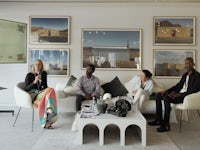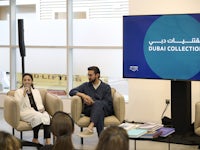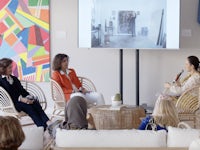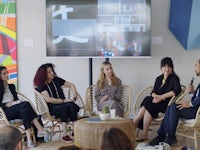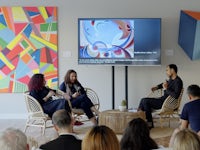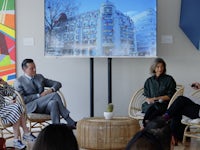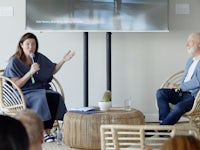Kampala-Baku
Both Kampala and Baku had dynamic art scenes between the 1960s and 1980s. Linking these two cities—and more generally, East Europe and East Africa—are the many art students and intellectuals who worked across these regions, absorbing and translating images, objects, and sounds from one context to another. This conversation brings these historical and present-day art worlds into focus, with experts who can speak to the challenges and opportunities of recovering lost histories and working in today’s global art market.
Cairo-Moscow
This talk shifts attention from Western institutions and their influence on modern art in the Arab World, focusing instead on overlooked yet impactful artistic and political connections between this culturally diverse region and the Soviet Union.
Almaty-Colombo
Though Central Asia and South Asia may seem to exist in different cultural and geographical hemispheres, artists working in these regions also had shared experiences in the late twentieth century: the rise of nationalisms, civil unrest, an interest in recovering native languages and art practices, and a desire to connect with a nascent global art world. For this talk, specialists in art from Central Asia and South Asia come together to highlight these parallel histories.
Collecting Beyond Borders: Dynamics and Diversity in Art Collection Practices Across the Global South
The talk uncovers the multifaceted stories of collectors who navigate the intersection of local and global, grappling with questions of identity, representation and cultural heritage – shining a light on diverse voices that make up the global artistic landscape. This conversation also examines the role these collectors play in shaping the perception of art from emerging cultural epicentres on the international stage.
Beyond the Private Vault: The Evolution of Collecting
The conversation unpacks the trajectory from private collecting towards institutional legacy in the Middle East and South Asia with patrons who have established their mark in private collecting and shifted their focus towards institution building. This panel aims to address the arising question: what happens to personal collecting efforts in light of this focus shift, in geographical regions where there is still more room for both?
Harmony in Patronage: Nurturing Art Ecosystems
An exploration into the intricate relationships between arts patrons and arts organisations that delves into the crucial role these patrons play in sustaining and enriching vibrant ecosystems of artistic expression. Examining how collaboration helps establish support systems for the production and dissemination of art, and drawing on contemporary case studies, this conversation uncovers the various dimensions of these dynamic partnerships from a regional perspective.
The Art of Collecting
This panel brought together a group of collectors with varying disciplines at different stages of their collecting journey, who shared insight about their practice. They shed light on the increasingly important role collectors play, and how they set their strategy and focus their patronage.
The Future of Institutional Collections: Perspectives From The Region
This conversation explored the process of developing new models for building publicly accessible art collections, where representatives from different institutions in the region discussed policy and curatorial concerns specific to their context.
Geographies of Land and Faces in MARWAN's World: Their Deconstruction & Reanimation
Pioneering artist MARWAN Kassab Bachi left his mark on the contemporary art scene, with his work celebrated in both Eastern and Western contexts. He influenced an entire generation of young artists, and this panel reflected on a lifetime of stories, friendships, inspirations, and the rich body of work that makes up his legacy.
Modern Art and Museums
The conversation reflected on possible ways to include and present modern art from MENASA countries in international museums and how to preserve the region’s heritage in the light of global market interest.
Are You Still Collecting Crypto In The Digital Winter?
What does it mean to be a collector of digital art today? In what is being dubbed as the ‘crypto winter’, the panelists discussed if it still makes sense to acquire digital works. Collectors Qinwen Wang and Fiorenzo Manganiello talked about where digital art sits during such a precarious time, the history of digital art (delineating digital art and NFTs), and their own involvement with it.
Abstraction and Figuration: Looking to Shapes
By critically reviewing the history of pictorial abstraction around the middle of the 20th century, the conversation reflected on the canons of artistic modernity by creating a bridge between past and present and reconsidering the theme of figuration in the light of experiences in the MENASA countries.
Luxury Retail and Art
As the world of art broadens its borders, luxury retail and art collaborations have been a natural outcome. This panel brought together leading representatives across the luxury retail and art worlds to discuss their involvement with the arts, how their affiliations and practices incorporate art, and the role that plays in the DNA of the organisations they represent.
Building a Collecting Community
This panel brought together UAE-based collectors to discuss their collecting journeys and practices over the years, how those have shifted in light of a growing cultural infrastructure, and the role they play in building collecting communities.
From Collector To Patron: Supporting Artistic Production In The Region and Beyond
This conversation explored forms of art patronage that support new media art and in specific video art, particularly in/for a region implementing new institutional models and cultural infrastructure. The talk highlighted new initiatives and patronage efforts with collectors engaged in impactful art endeavours, with a focus on the role of commissioning private institutions in supporting the production and exhibition of digital and video art. The conversation brought together Han Nefkens, collector and founder of the Han Nefkens Foundation, which supports emerging international video artists through awards, production grants and mentorship grants, and Antonia Carver, director of Art Jameel.
Collecting In A Shifting Global Cultural Map
The role collecting and collectors are playing in shifting arts and culture landscapes, as well as in the redistribution of global cultural centres. This panel brought light on new collecting emerging in the Global South, the impact these new collectors had on the cities/geographies they’re based in, and the effect of these practices in the larger global conversation around diversity and inclusion of art from beyond traditional western-led geographical scopes.
On Creating: Maitha Abdalla
On Creating: Nima Nabavi
We met up with Nima Nabavi to discuss what creating means to him. He told us about his grandfather’s influence on his practice, how growing up in 80s Dubai transformed the way he understands aesthetics, and the puzzle of sacred geometries found in nature. Nima Nabavi is a self-taught artist based between Dubai and New York. His practice centers on geometric abstraction and its connection to the natural world and quantum processes. Drawing on an ever-expanding set of tools, ranging from the traditional to the technological, Nabavi creates grid-based compositions of elaborately layered, imagined ordered forms. His mathematical approach and repetitive numeric symbolism rely heavily on advanced planning, precise calculations, and self-developed methodologies to ensure the vital structural accuracy of each work.
On Creating: Tagreed Darghouth
On Creating: Juma Al Haj
We visited Juma Al Haj's studio in Sharjah to discuss what creating means to him. He shared the meaning of religious texts with us and how they impact his work, from language to design, the importance of finding inspiration outside of one’s practice, and how his experiences abroad have shaped his identity.
